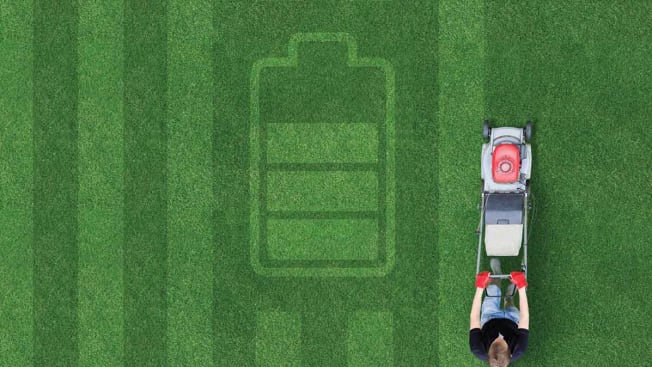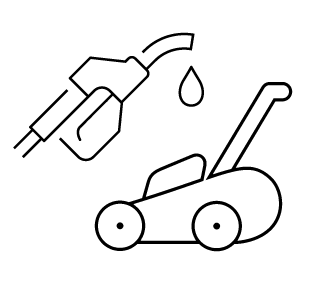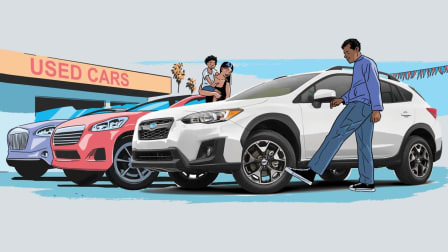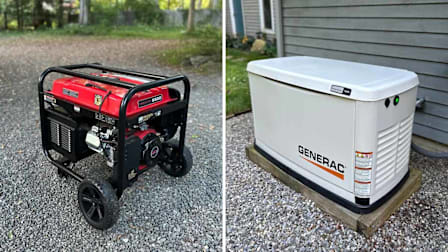5 Green Reasons to Choose Battery-Powered Lawn Tools
Cordless electric mowers, string trimmers, and leaf blowers now perform better than ever. And compared with gas-powered options, they're kinder to the environment, too.
When you shop through retailer links on our site, we may earn affiliate commissions. 100% of the fees we collect are used to support our nonprofit mission. Learn more.

The irony of lawn tools is that they’re often destroying the same outdoor spaces we are hoping to maintain and manicure. That’s because some of them are causing more harm to the environment than many people realize.
Gas-powered outdoor equipment, including leaf blowers and lawn mowers, emit an outsized share of carbon dioxide, nitrogen oxides, and volatile organic compounds (VOCs).
There are 650 million gas-powered outdoor tools currently in use in the U.S., according to a 2021 study from The Freedonia Group, a division of MarketResearch.com. And each one contributes to climate change.
“When you look nationally at the pollution from gas-powered yard tools, the numbers are pretty staggering,” says Simon Mui, PhD, director of the Clean Vehicles & Fuels Group, part of the Climate & Clean Energy Program at the Natural Resources Defense Council. “These little lawn tools with two-stroke engines are, in some cases, putting out 20 to nearly 300 times the emissions of a car every hour they’re running.” (Two-stroke engines are commonly used in handheld lawn tools like chainsaws and string trimmers; these are even less efficient than the four-stroke engines used in gas tools with wheels, like lawn mowers and snow blowers.)


Source: Simon Mui/Natural Resources Defense Council.
Fortunately, battery-powered models are now a truly viable option. “Every year we test more battery tools, and every year we find fewer reasons to recommend buying gas tools,” says Misha Kollontai, the CR engineer who oversees the testing of all outdoor power equipment.
1. A Battery-Powered Motor Produces Zero Emissions
That stands in stark contrast to the two-stroke engines that power many gas tools. These gas tools not only pollute but also are dirtier than car engines. That’s because they’re far less efficient and don’t have the emissions-capturing technology that regulations have made standard in the auto industry.
Consider this: Running a commercial gas-powered leaf blower for just an hour produces about as much pollution as driving a 2017 Toyota Camry 1,100 miles, according to the California Air Resources Board.


Source: California Air Resources Board.
2. Battery-Powered Tools Are More Efficient
Because electric motors are typically more efficient than gas engines, they require less energy input to do the same amount of work. Gasoline engines generate a significant amount of heat during the combustion phase, which is just wasted energy. Electric motors don’t typically have the same waste-heat problem as gasoline engines, so more of the energy they generate goes directly toward powering the tool.
3. You Can Recharge Them
Any form of energy comes at some cost to the environment. The lithium-ion batteries that power these lawn tools need to be recharged with electricity, so they contribute to greenhouse gas emissions indirectly by taking energy generated by power plants.
“But it’s a fraction of the harmful emissions produced by running gas tools,” Mui says.
And if your utility company relies in part on renewable energy, such as wind and solar power, the carbon footprint of using your electric tool gets even smaller.
You can find out where your area stands by entering your ZIP code into the EPA’s Power Profiler to see how much of the energy you use is generated by oil, natural gas, and renewable sources.
One side note: If you purchase multiple tools from the same manufacturer platform, you can use one battery interchangeably for all of them. And for each tool you purchase without a battery, you pay around 30 percent less.
4. There’s No Risk of Spilled Gasoline
It’s almost inevitable that you’ll spill a few drops of gas when refilling the tank of a lawn mower or string trimmer, or when filling up a container at a gas station.
That’s because when you’re filling a gas container, a gas pump’s shutoff mechanism doesn’t activate the way it does when you’re filling your car’s tank. So you’re more likely to overfill your container. “That spilled gasoline can contaminate groundwater and aquatic systems, potentially exposing people to dangerous hydrocarbons like benzene and toluene,” says Andrew Zimmerman, a professor of geological sciences at the University of Florida.
And while your small spill may seem like no big deal, consider that you’re one of millions of people making that mistake. “If you added up all the spilled fuel across the country each year,” Mui says, “you’d probably end up with something that resembled a large-scale oil spill.”


Source: Simon Mui/Natural Resources Defense Council.
5. Battery-Powered Tools Are More Reliable Than You Might Think
At CR we regularly conduct member surveys in which we ask our members to tell us about problems they experienced with their outdoor power equipment. We use that data to estimate how reliable newly purchased tools will be through the fourth or fifth year of ownership. The more reliable the tool, the less likely it will quickly end up in a landfill.
What we discovered: Battery-charged trimmers and leaf blowers turn out to be more reliable than gas ones. For instance, almost all the battery string-trimmer brands we test earn a favorable rating or above for predicted reliability, while less than half of the gas brands we rate score as well. As for leaf blowers, most handheld battery-powered brands earn a favorable or very favorable reliability rating. No handheld gas brand earns more than a midlevel reliability rating. In fact, a majority of brands warrant unfavorable or very unfavorable ratings.
We see more variability with battery-charged lawn mowers, but almost all of the cordless electric mower brands for which we have adequate data earn a midlevel rating or better—and a handful of brands earn top-level or near top-level ratings. Most gas mower brands are also rated midlevel or better, but there are more gas brands that do not receive acceptable reliability ratings.
Overall, as battery-powered lawn tools of all kinds have improved, so have their warranties. Many brands have started offering lengthier warranties of two or three years as opposed to one year, which was pretty standard when battery tools first came out. So when a problem arises with a battery-powered lawn tool, it may be easier to have it fixed than in the past, as opposed to throwing it out. That’s good for the earth and for your wallet, too.
5 Standout Battery-Powered Lawn Tools
You can count on the lawn mower, string trimmer, leaf blower, chainsaw, and snow blower below to provide terrific performance while producing zero emissions as you tackle your yardwork.




















